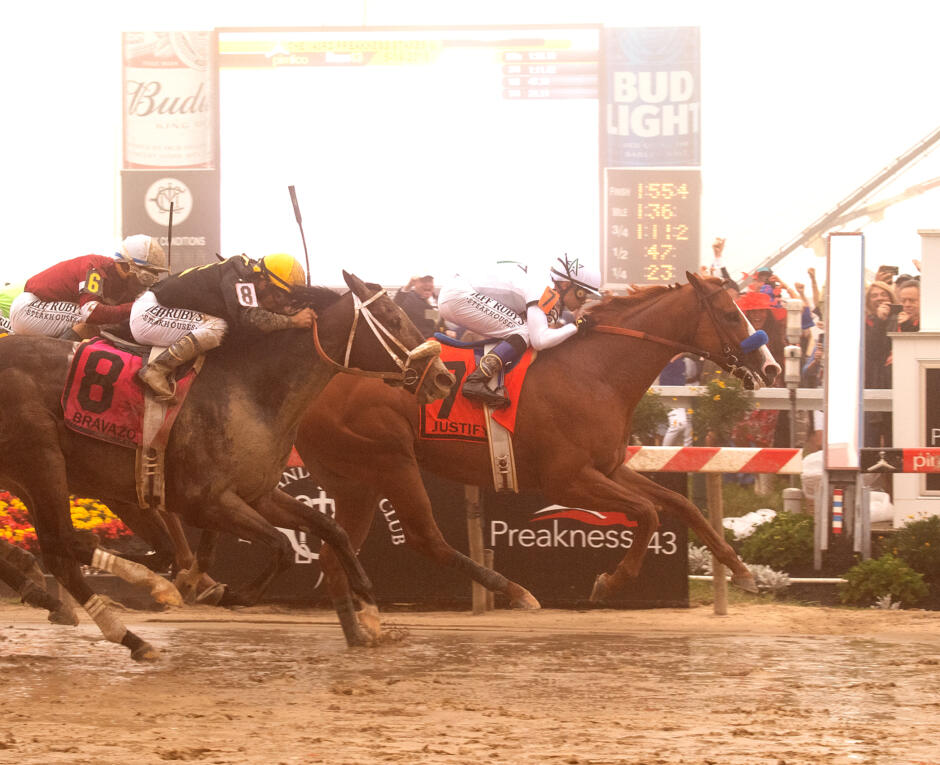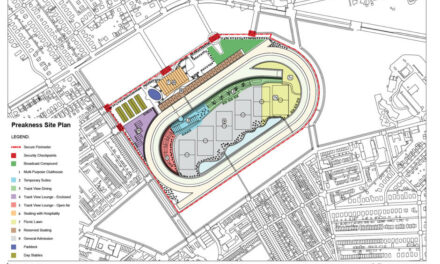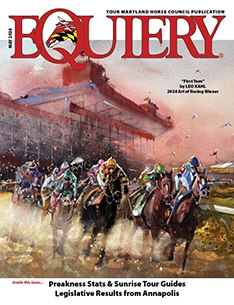first published in the May 2021 Equiery
By Olivia Wood, Equiery Intern
The Preakness Stakes at Pimlico Race Course this month may be the 146th running of this second jewel in the Triple Crown, however, Maryland’s Thoroughbred racing history starts over a century earlier than the first Preakness with the industry’s roots dating back to mid-18th century Colonial Maryland.
Maryland was the first colony to organize the sport with the founding of the Maryland Jockey Club in 1743. Two years later, the first official Thoroughbred-only race in the colonies was held in Annapolis, with the winning owner receiving a silver punch bowl called the Annapolis Subscription Plate. The race was organized by Samuel Ogle, Proprietary Governor of Maryland for most of the period from 1731 until his death in 1752, when he ordered an “English style” race at Annapolis in 1745.

The Belair Stud Farm in Bowie still stands today with a Maryland Historical Society plaque marking the site the “Cradle of American Racing.” (Katherine O. Rizzo photo)
The Ogles and Taskers
Samuel Ogle is credited by many with bringing Thoroughbred racing from England to North America when he and his brother-in-law, Colonel Benjamin Tasker, imported several Thoroughbred horses from England in the late 1740s with the hope of strengthening local racing bloodlines. Their breeding operation was housed at the Ogle’s Belair Stud in Collington, which was later run by Tasker.
Their most notable import was the English mare Selima who not only had a stellar racing career, but produced winning offspring with her bloodlines still found in racing today. She is considered one of the foundation mares of the American Thoroughbred.
Although changing hands many times over its 200 years as a racing stable, Belair Stud is considered one of the most important stables in the nation, producing such great horses as Triple Crown winners Gallant Fox (1930), Omaha (1935) and Nashua (1955). The stables and mansion still stand today as the Belair Stable Museum and are open to visitors looking to learn more about the “Cradle of American Thoroughbred Racing.”
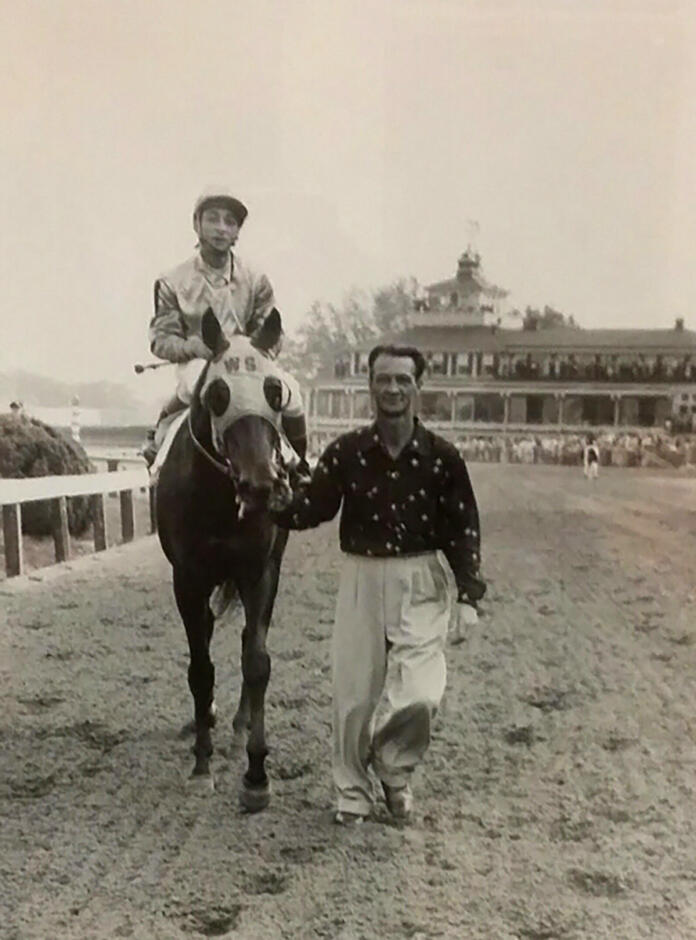
Survivor, ridden by George Barbee, trained by A. Davis Pryor and owned by John F. Chamberlain, was the first Preakness Stakes winner in 1873. (MJC Archives)
Racing Halted by Wars
The Revolutionary War brought a halt to racing in Maryland as it did to so many other aspects of American life, with many racehorses being conscripted for cavalry mounts and other military uses. After the Treaty of Paris was signed in 1783, Governor William Paca and Charles Carroll helped the Maryland Jockey Club bring the sport of Thoroughbred racing back to life once again.
Despite this strong start to the racing tradition in Maryland, the Revolutionary War naturally dampened what had been a growing interest in racing. Nevertheless, months before the war’s official end in 1783, Maryland Jockey Club members Governor William Paca and Charles Carroll became presiding officers of the club and helped reorganize it in the war’s wake.
The Civil War brought racing to a halt once again, when Thoroughbreds that were once in demand for their athleticism on the track became sought after for utilitarian, war-related needs, like carrying equipment. As an interesting side note, the Woodlawn Vase that would eventually be given to every Preakness Stakes winner starting in 1917, was buried at Thomas G. Moore’s Woodlawn Farm in Kentucky in 1862 for fear Confederate troops would melt it down for ammunition. The priceless trophy was created by Tiffany, Co. in 1860 and was first awarded in 1861 to Moore’s filly Mollie Jackson in Louisville. Moore dug the trophy out after the war and it changed hands several times before becoming the official Preakness trophy. The trophy is now housed in the Baltimore Museum of Art with a smaller replica given to the winning owner each year.
Just three years after the Civil War ended, then-Governor Oden Bowie boasted at a party in New York that he could build an even more impressive racetrack than Saratoga, the country’s first racetrack. Governor Bowie was true to his word, opening what is now the iconic Pimlico Race Course on October 25, 1870. The featured race on opening day was the Dinner Party Stakes (run today as the Dixie Handicap). It was won by a horse named Preakness. He gave his name to the Preakness Stakes, first run three years later, on May 23, 1873. The first Preakness Stakes was won by Kentucky-bred Survivor for a purse of $1,000.
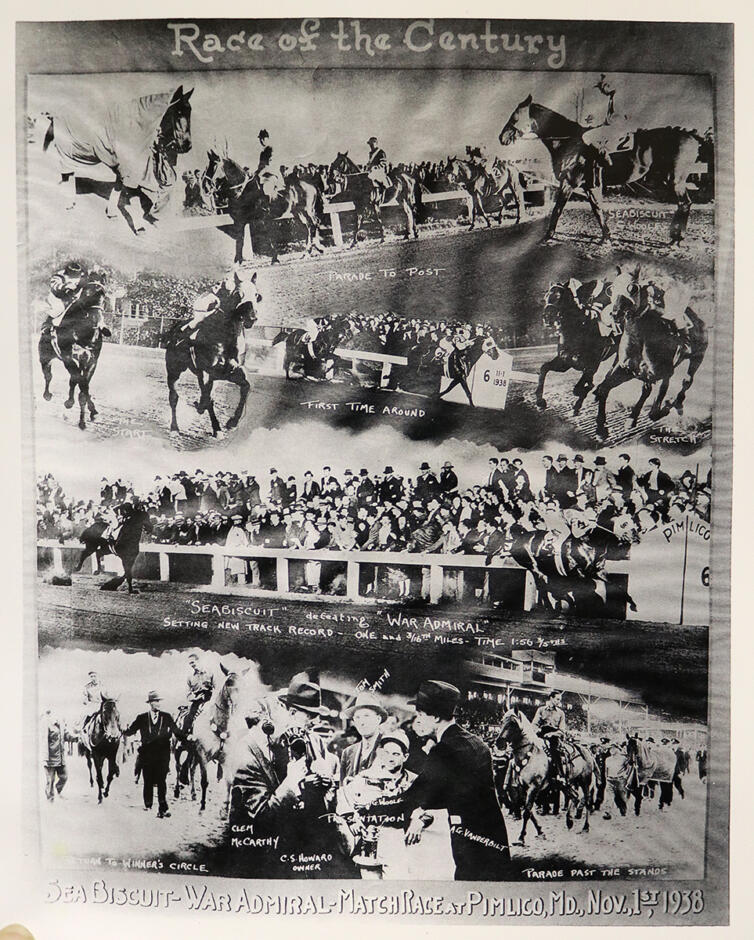
A poster celebrating the famed “Race of the Century” between War Admiral and Seabiscuit. The race was held November 1, 1938 during the hieght of the Great Depression and ignited hope in many working class Americans. (MJC Archives)
The Golden Age
The Preakness Stakes would remain at home in Baltimore until 1890, when, in a massive blow to Maryland’s Thoroughbred horse racing culture, the event was moved to New York due changes in wagering leading to its increasing lack of profitability in Baltimore. However, in 1909, the Preakness returned to its home at Pimlico.
An anti-gambling movement drove racing events like the Preakness out of New York. It had not taken such a strong hold in Maryland, which allowed Maryland to reclaim the Preakness Stakes. Thus was ushered in a golden age of horse racing in Maryland. During this time, new racetracks opened all over the state, including those at Marlboro (1910), Laurel Park (1911), Havre de Grace (1912), Bowie (1914), Cumberland (1924), Hagerstown (1929) and Bel Air (founded in early 1870s, reopened in 1937).
During the Great Depression, racing became even more popular as an escape from the day-to-day worries facing many Americans, with nearly 15,000 races held throughout the country in 1934. It was also during the Great Depression that all eyes fell on Maryland as the much anticipated “Match Race of the Century” between War Admiral and Seabiscuit was run at Pimlico.
On November 1, 1938, these two racing legends faced off at Pimlico to a packed crowed of around 40,000 fans with 40 million listening to the call on the radio. Two hundred yards from the finish, the under-dog Seabiscuit pulled to the front and extended his lead to win by four lengths over War Admiral. Seabiscuit’s win ignited a nation and is often credited with inspiring many working class Americans to hold on to hope and move forward through the Great Depression.
Seabiscuit wasn’t the only Depression-era horse to thrill Maryland race fans, as the state had many champions with Maryland connections to cheer for. His rival in the match race, the 1937 Triple Crown winner War Admiral, trained at the great Glen Riddle Farm here in Maryland, which also produced his sire, Man o’War.
Man o’War was named the 1920 Horse of the Year after winning the Preakness Stakes and Belmont Stakes. Two out of three Belair Stud Triple Crown winners, Gallant Fox and Omaha, the only father/son duo to win the Triple Crown, were also big names during the Great Depression, shining a strong light on Maryland Thoroughbred racing.
Sagamore Farm in Reisterstown was another bastion of Depression-era racing. Isaac Emerson established the farm in 1925 for his daughter, Margaret Emerson Vanderbilt. Sagamore began building bloodlines with the purchase of Discovery in 1933. Nicknamed “The Iron Horse,” Discovery sired influential broodmares that produced such greats at Native Dancer and Bold Ruler. Margaret’s son Alfred Vanderbilt, Jr., was given the farm after Emerson’s death. Vanderbilt also became president of Pimlico twice, once in 1932 and again in 1938, during which time he modernized the track and marketed it on a national scale.

The first Maryland Million Day was held on October 18, 1986 as a day to celebrate and promote Maryland-bred horses. Founded by Jim McKay, the day of racing continues today under the new name Jim McKay Maryland Million Day with Monday Morning Qb being the most recent Maryland Million Classic winner (2020). (Jim McCue photo)
New Era of Racing
Television transformed the sport of Thoroughbred racing in Maryland. WMAR out of Baltimore was the first Maryland station to air live racing with two races live from Pimlico in 1947. The broadcast was hosted by Jim McManus (known professionally as Jim McKay) and Jim Kelley.
McKay, who spent the majority of his life in Baltimore, became a nationally and internationally known sportscaster and sportswriter. He was the mastermind behind the annual day of racing held specifically to highlight Maryland-bred horses. First known as Maryland Million Day, the traditional 12-card race day is now called the Jim McKay Maryland Million Day and is the second most popular day of racing in Maryland behind the Preakness Day.
The first racehorse to become a television star was Sagamore Farm’s Native Dancer. Over the course of his career, Native Dancer won 21 of his 22 races and was Horse of the Year in 1952 and 1954. He appeared on the the cover of Time magazine and was considered one of the top television personalities in America by TV Guide in 1953. When Native Dancer retired, his many adoring fans came to Sagamore to visit him in person. The “Gray Ghost” is buried at Sagamore and visitors still flock to his grave.
In 1953, Vanderbilt, Jr., sold Pimlico Race Course to Ben and Nathan Cohen. The Cohen brothers continued to modernize Pimlico, including expanding the seating.
Around the same time, in 1950, Morris Shapiro became the new owner of the Laurel Park Race Track. Shapiro placed his son, John Shapiro, in charge of the track and assigned his son-in-law, Major League baseball pitcher, Joe Cascarella, to head public relations. In an effort to reinvigorate the declining track attendance, John Shapiro came up with an idea for an international, invitation-only race to be held at Laurel.
Shapiro’s first invitational ran at Laurel Park in 1952 as the Washington, D.C., International Stakes. The International grew in prestige over its 43-year run and attracted the attention of many important people, including Queen Elizabeth II of England. Even the Soviet Union ran horses despite the Cold War in the 1960s.
The International would ultimately become the inspiration for the Breeders’ Cup World Championships and was discontinued in 1994. It was brought back as the Colonial Turf Cup in 2005 at Colonial Downs and returned to Laurel Park in 2015 as the Commonwealth Turf Cup. In 2017, the race, which remains at Laurel Park, was renamed the Baltimore Washington International Turf Cup.

Deputed Testamony’s 1983 Preakness win marks the last time a Maryland-bred has won the Preakness Stakes. (MJC Archives)
Racing in the Late 20th Century
As horse racing across the country moved into the 1980s, Maryland’s Deputed Testamony won the Preakness Stakes in 1983, the last Maryland-bred to do so. He was bred in Maryland by J. William Boniface and Francis P. Sears, trained in Maryland at Bonita Farm, and was ridden by Maryland-based jockey Donnie Miller. The Deputed Testamony Stakes was named in his honor and has been run each February at Laurel Park since 1985.
It was also in the mid-1980s that Jim McKay founded Maryland Million Day. The first Maryland Million Classic – for horses sired by stallions standing in Maryland – winner was John A. Franks’ Herat. Herat’s sire, Canadian super horse Northern Dancer, was relocated to the Maryland division of Windfields Farm in December 1968.
However, racing’s allure seemed to have lost its spark as handles and attendance declined. Washington, D.C., lawyer Frank deFrancis and his partners Bob Manfuso and Tom Manfuso bought both Pimlico and Laurel and injected some much needed cash into the operations. DeFrancis died suddenly of a heart attack in 1989. The De Francis Memorial Dash is run in his honor and is the final race in this year’s Mid Atlantic Thoroughbred Championships (MATCH Series).
Frank deFrancis’ son Joe deFrancis took over his stake in the tracks and continued operating Pimlico and Laurel Park with the Manfusos until he bought them out in 1993. Bob Manfuso, who continued breeding and training race horses out of Chanceland Farm in West Friendship, died in 2020 at the age of 82.
The late 20th century brought reversals to Maryland racing, driven in part by policy decisions at the state level. Unlike Maryland, nearby states approved slots at racetracks and handles declined in Maryland as bettors went elsewhere. Purses in Delaware, New Jersey, and Pennsylvania dwarfed those available in Maryland.
It was not until 2008 that Maryland voters approved a state constitutional amendment permitting slot machines and allowing a portion of the slots revenue to be used for reviving the horse racing industry. This amendment aided the struggling Maryland Thoroughbred industry significantly, and breeders began coming back to Maryland to continue Maryland’s long and impressive history of Thoroughbred breeding and racing.
Thoroughbred Racing Today
The economics of Thoroughbred racing in Maryland today have improved somewhat since the late 20th century. The Stronach Group, now called 1/ST Racing, purchased Laurel Park and Pimlico in 2002. The company has made capital investments in the barns and clubhouse at Laurel Park, and is working with state and local authorities to make significant capital investments in Pimlico.
In addition, Maryland now permits slots at racetracks, and in April of this year, the General Assembly expanded wagering on horse racing to permit betting at all six casinos in the state, as well as at M&T Stadium and Oriole Park.
Maryland Thoroughbred racing has also risen above the COVID-19 pandemic and was able to hold 140 racing days with limited spectators in 2020. The typical racing calendar was a bit jumbled with the summer meet at Timonium being canceled and the Preakness Stakes being pushed to October as the final race in the 2020 Triple Crown.
The Preakness returns to May this year, and to its traditional spot as the middle Triple Crown race, as the crown jewel of Maryland’s 2021 racing calendar featuring 170 racing days, including seven days of live racing at Timonium.
Interested in more history about Maryland Thoroughbred Racing? Check out the sources below!
• “The Preakness: An American Classic”
https://equiery.com/the-preakness-an-american-classic/
• “The History of the Godolphin Barb”
https://equiery.com/the-history-of-the-godolphin-barb/
• “Maryland’s Horse: The Iconic Thoroughbred”
https://equiery.com/marylands-horse-the-iconic-thoroughbred/
• “Maryland at a Glance: Horse Racing”
https://msa.maryland.gov/msa/mdmanual/01glance/sports/html/horse.html
• Racing the Times, MPT
https://www.pbs.org/video/mpt-presents-racing-times/
• Belair Stable Museam
https://www.cityofbowie.org/289/Belair-Stable-Museum
• 2021 Maryland Jockey Club Media Guide: Maryland Jockey Club History
https://www.pimlico.com/wp-content/uploads/2021/04/2021_MJC_Media_Guide_FINAL.pdf

